Petrogenesis and Tectonic Implications of the Oligocene Dalongtan Shoshonitic Syenite Porphyry in Central Yunnan, Southeastern Tibetan Plateau: Constraints from Geochronology, Geochemistry and Sr-Nd-Hf Isotopes
Abstract
1. Introduction
2. Geological Setting and Petrography
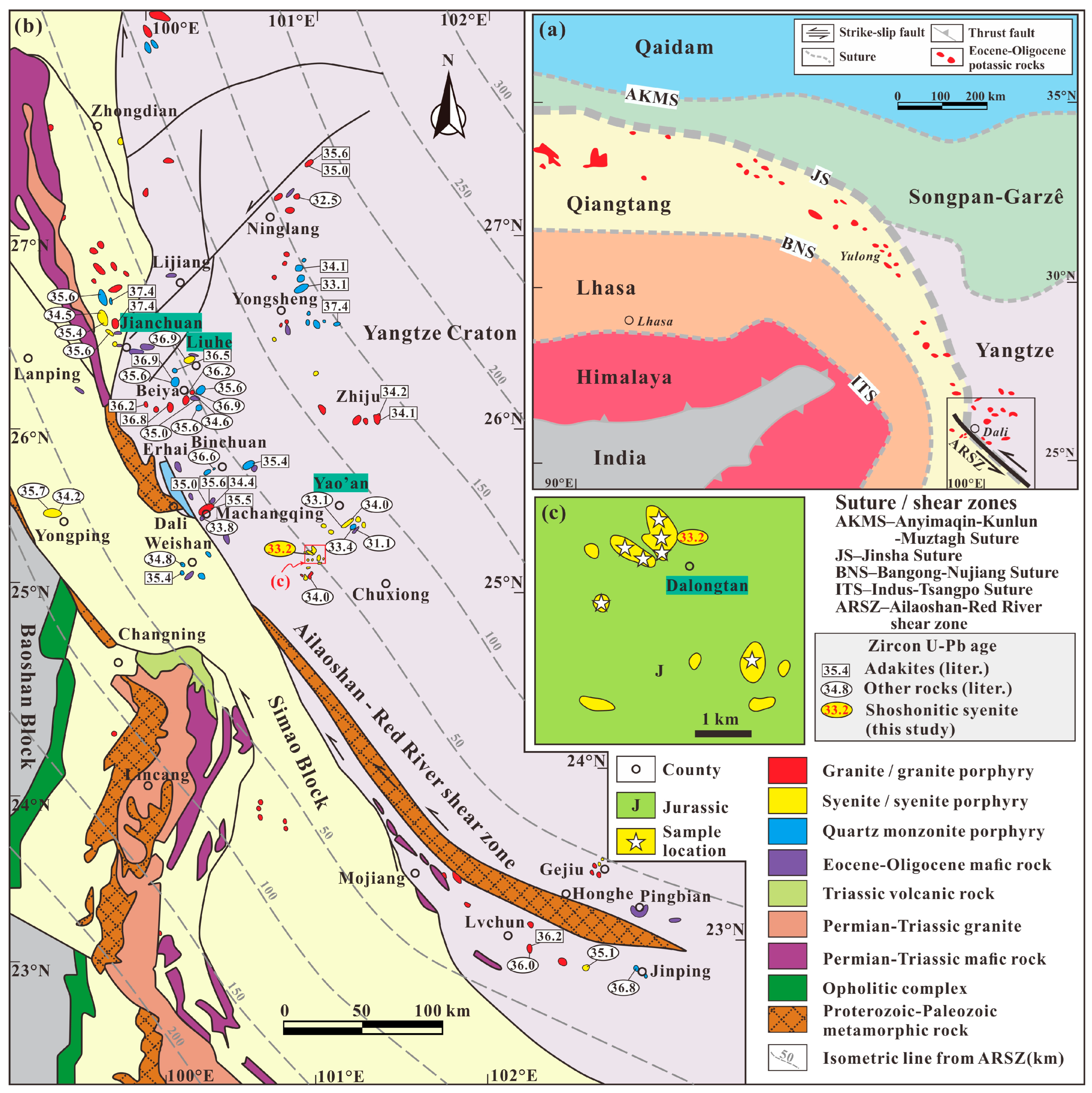
3. Analytical Methods
3.1. Zircon Trace Elemental Analyses, U-Pb Dating, and Hf Isotopic Analyses
3.2. Bulk-Rock Major and Trace Elemental Analyses
3.3. Bulk-Rock Sr-Nd Isotopic Analyses
4. Results
4.1. Zircon Trace Elemental and U-Pb Results
| Spot | Pb | Th | U | Common Pb | Th/U | 207Pb/206Pb | 207Pb/235U | 206Pb/238U | 207Pb/206Pb | 207Pb/235U | 206Pb/238U | Concordance | ||||||
|---|---|---|---|---|---|---|---|---|---|---|---|---|---|---|---|---|---|---|
| ppm | ppm | ppm | ppm | Ratio | 1σ | Ratio | 1σ | Ratio | 1σ | Age | 1σ | Age | 1σ | Age | 1σ | |||
| DLT-1-01 | 1.83 | 378.13 | 239.63 | 0.00 | 1.6 | 0.04671 | 0.00563 | 0.03054 | 0.00301 | 0.00512 | 0.00013 | 35.3 | 266.6 | 30.6 | 3.0 | 32.9 | 0.9 | 92% |
| DLT-1-02 | 2.30 | 511.77 | 283.44 | 0.04 | 1.8 | 0.04740 | 0.00482 | 0.03205 | 0.00258 | 0.00508 | 0.00011 | 77.9 | 216.6 | 32.0 | 2.5 | 32.7 | 0.7 | 98% |
| DLT-1-03 | 2.51 | 517.11 | 307.39 | 0.28 | 1.7 | 0.05226 | 0.00479 | 0.03651 | 0.00275 | 0.00532 | 0.00011 | 298.2 | 211.1 | 36.4 | 2.7 | 34.2 | 0.7 | 93% |
| DLT-1-04 | 3.23 | 583.36 | 440.63 | 0.16 | 1.3 | 0.04806 | 0.00340 | 0.03350 | 0.00220 | 0.00510 | 0.00009 | 101.9 | 159.2 | 33.5 | 2.2 | 32.8 | 0.6 | 97% |
| DLT-1-05 | 2.15 | 443.20 | 269.02 | 0.00 | 1.6 | 0.04637 | 0.00475 | 0.03272 | 0.00276 | 0.00526 | 0.00011 | 16.8 | 238.9 | 32.7 | 2.7 | 33.8 | 0.7 | 96% |
| DLT-1-06 | 5.00 | 1119.07 | 602.31 | 0.00 | 1.9 | 0.04732 | 0.00320 | 0.03313 | 0.00201 | 0.00517 | 0.00008 | 64.9 | 155.5 | 33.1 | 2.0 | 33.2 | 0.5 | 99% |
| DLT-1-07 | 1.33 | 251.01 | 167.79 | 0.00 | 1.5 | 0.05374 | 0.00737 | 0.03626 | 0.00416 | 0.00527 | 0.00014 | 361.2 | 312.9 | 36.2 | 4.1 | 33.9 | 0.9 | 93% |
| DLT-1-08 | 6.07 | 1282.36 | 739.77 | 0.00 | 1.7 | 0.04856 | 0.00291 | 0.03434 | 0.00183 | 0.00520 | 0.00007 | 127.9 | 133.3 | 34.3 | 1.8 | 33.4 | 0.5 | 97% |
| DLT-1-09 | 1.53 | 276.03 | 208.06 | 0.00 | 1.3 | 0.05443 | 0.00664 | 0.03560 | 0.00325 | 0.00526 | 0.00014 | 387.1 | 277.7 | 35.5 | 3.2 | 33.8 | 0.9 | 95% |
| DLT-1-10 | 1.62 | 324.37 | 202.07 | 0.00 | 1.6 | 0.05906 | 0.00792 | 0.03761 | 0.00371 | 0.00530 | 0.00017 | 568.6 | 291.6 | 37.5 | 3.6 | 34.1 | 1.1 | 90% |
| DLT-1-11 | 6.92 | 1516.30 | 833.37 | 0.03 | 1.8 | 0.04997 | 0.00322 | 0.03394 | 0.00187 | 0.00506 | 0.00007 | 194.5 | 154.6 | 33.9 | 1.8 | 32.5 | 0.5 | 95% |
| DLT-1-12 | 1.59 | 303.59 | 206.71 | 0.00 | 1.5 | 0.04682 | 0.00499 | 0.03280 | 0.00337 | 0.00517 | 0.00012 | 39.0 | 237.0 | 32.8 | 3.3 | 33.2 | 0.7 | 98% |
| DLT-1-13 | 8.08 | 1862.66 | 934.02 | 0.02 | 2.0 | 0.04685 | 0.00215 | 0.03359 | 0.00157 | 0.00522 | 0.00006 | 42.7 | 103.7 | 33.5 | 1.5 | 33.6 | 0.4 | 99% |
| DLT-1-14 | 1.17 | 206.09 | 146.56 | 0.36 | 1.4 | 0.05059 | 0.00697 | 0.03573 | 0.00391 | 0.00554 | 0.00016 | 220.4 | 301.8 | 35.6 | 3.8 | 35.6 | 1.1 | 99% |
| DLT-1-15 | 6.64 | 1413.88 | 850.06 | 0.46 | 1.7 | 0.05188 | 0.00310 | 0.03541 | 0.00197 | 0.00500 | 0.00006 | 279.7 | 106.5 | 35.3 | 1.9 | 32.2 | 0.4 | 90% |
| DLT-1-16 | 2.53 | 454.44 | 343.95 | 0.09 | 1.3 | 0.04739 | 0.00457 | 0.03280 | 0.00285 | 0.00510 | 0.00009 | 77.9 | 205.5 | 32.8 | 2.8 | 32.8 | 0.6 | 99% |
| DLT-1-17 | 1.90 | 358.39 | 237.78 | 0.00 | 1.5 | 0.04825 | 0.00532 | 0.03333 | 0.00247 | 0.00547 | 0.00030 | 122.3 | 231.5 | 33.3 | 2.4 | 35.2 | 1.9 | 94% |
| DLT-1-18 | 6.67 | 1371.96 | 818.03 | 0.00 | 1.7 | 0.04721 | 0.00280 | 0.03384 | 0.00206 | 0.00519 | 0.00007 | 61.2 | 133.3 | 33.8 | 2.0 | 33.4 | 0.4 | 98% |
| DLT-1-19 | 1.40 | 272.84 | 181.02 | 0.04 | 1.5 | 0.05406 | 0.00685 | 0.03508 | 0.00379 | 0.00505 | 0.00011 | 372.3 | 287.0 | 35.0 | 3.7 | 32.5 | 0.7 | 92% |
| DLT-1-21 | 3.43 | 715.40 | 405.04 | 0.00 | 1.8 | 0.05002 | 0.00421 | 0.03603 | 0.00247 | 0.00544 | 0.00011 | 194.5 | 194.4 | 35.9 | 2.4 | 35.0 | 0.7 | 97% |
| DLT-1-22 | 3.23 | 747.15 | 393.34 | 0.00 | 1.9 | 0.04699 | 0.00426 | 0.03157 | 0.00248 | 0.00515 | 0.00009 | 55.7 | 198.1 | 31.6 | 2.4 | 33.1 | 0.6 | 95% |
| Spot | Age (Ma) | Ti | Y | Nb | La | Ce | Pr | Nd | Sm | Eu | Gd | Tb | Dy | Ho | Er | Tm | Yb | Lu | Hf | Ta | U | Eu/Eu* | Ce/Ce* | ΔFMQ |
|---|---|---|---|---|---|---|---|---|---|---|---|---|---|---|---|---|---|---|---|---|---|---|---|---|
| 01 | 32.9 | 8.87 | 574 | 1.88 | 0.02 | 88.4 | 0.21 | 3.22 | 4.16 | 2.62 | 20.1 | 5.39 | 53.3 | 18.4 | 73.9 | 14.9 | 133 | 26.2 | 7409 | 0.59 | 240 | 0.72 | 126 | 3.41 |
| 02 | 32.7 | 9.26 | 671 | 2.45 | 0.06 | 108 | 0.36 | 4.01 | 6.14 | 3.00 | 23.8 | 6.31 | 64.8 | 21.1 | 87.0 | 17.3 | 151 | 29.6 | 7355 | 0.65 | 283 | 0.66 | 88 | 3.57 |
| 03 | 34.2 | 8.94 | 657 | 2.34 | 0.02 | 107 | 0.28 | 4.04 | 5.38 | 2.99 | 22.8 | 6.12 | 62.7 | 20.0 | 85.0 | 16.6 | 151 | 29.5 | 7617 | 0.68 | 307 | 0.71 | 115 | 3.51 |
| 04 | 32.8 | 7.63 | 1426 | 6.65 | 0.06 | 155 | 0.36 | 5.01 | 7.26 | 3.98 | 31.1 | 9.72 | 112 | 41.5 | 190 | 39.7 | 365 | 72.9 | 7701 | 0.89 | 441 | 0.69 | 125 | 3.99 |
| 05 | 33.8 | 9.76 | 655 | 2.52 | 0.03 | 105 | 0.26 | 4.32 | 5.07 | 2.93 | 23.2 | 6.10 | 62.3 | 20.1 | 82.9 | 16.8 | 152 | 29.9 | 7847 | 0.58 | 269 | 0.69 | 121 | 3.52 |
| 06 | 33.2 | 7.81 | 1161 | 5.42 | 0.03 | 191 | 0.39 | 6.10 | 8.69 | 4.52 | 34.9 | 9.97 | 101 | 34.6 | 149 | 30.2 | 276 | 53.9 | 7737 | 1.10 | 602 | 0.69 | 148 | 4.06 |
| 07 | 33.9 | 10.3 | 535 | 1.54 | 0.03 | 75.0 | 0.26 | 2.95 | 4.79 | 2.57 | 18.1 | 5.28 | 51.9 | 17.2 | 70.7 | 13.9 | 122 | 23.9 | 7266 | 0.50 | 168 | 0.74 | 86 | 3.30 |
| 08 | 33.4 | 4.68 | 1052 | 5.28 | 0.04 | 179 | 0.31 | 3.95 | 6.57 | 3.52 | 28.9 | 8.43 | 88.0 | 31.1 | 136 | 27.4 | 255 | 50.0 | 8303 | 1.00 | 740 | 0.66 | 172 | 4.21 |
| 09 | 33.8 | 7.38 | 610 | 2.27 | 0.02 | 88.1 | 0.21 | 3.55 | 4.36 | 2.42 | 19.7 | 5.37 | 54.3 | 18.8 | 80.0 | 16.1 | 146 | 29.3 | 7759 | 0.62 | 208 | 0.67 | 122 | 3.68 |
| 10 | 34.1 | 9.10 | 625 | 1.96 | 0.03 | 88.3 | 0.23 | 3.85 | 5.34 | 2.76 | 19.8 | 5.78 | 57.6 | 19.4 | 81.3 | 15.8 | 141 | 28.3 | 6965 | 0.49 | 202 | 0.72 | 112 | 3.53 |
| 11 | 32.5 | 6.89 | 1259 | 7.20 | 0.05 | 217 | 0.38 | 5.55 | 8.53 | 4.36 | 34.6 | 9.94 | 104 | 36.4 | 158 | 32.9 | 300 | 59.6 | 8266 | 1.33 | 833 | 0.67 | 169 | 4.11 |
| 12 | 33.2 | 8.71 | 605 | 2.10 | 0.03 | 88.7 | 0.26 | 3.59 | 4.73 | 2.50 | 19.9 | 5.62 | 56.6 | 18.7 | 79.1 | 15.6 | 138 | 28.5 | 7654 | 0.63 | 207 | 0.67 | 102 | 3.56 |
| 13 | 33.6 | 5.64 | 1371 | 8.14 | 0.06 | 250 | 0.38 | 5.87 | 9.24 | 4.84 | 38.5 | 11.0 | 114 | 39.6 | 172 | 34.8 | 314 | 60.8 | 8176 | 1.34 | 934 | 0.67 | 195 | 4.43 |
| 14 | 35.6 | 7.02 | 572 | 1.80 | 0.03 | 78.8 | 0.26 | 3.78 | 4.36 | 2.50 | 20.1 | 5.46 | 54.1 | 17.8 | 75.0 | 14.7 | 129 | 26.0 | 7233 | 0.52 | 147 | 0.68 | 90 | 3.84 |
| 15 | 32.2 | 4.35 | 1833 | 8.39 | 0.06 | 239 | 0.54 | 7.79 | 11.9 | 5.95 | 50.4 | 14.1 | 150 | 54.0 | 235 | 48.5 | 445 | 87.5 | 8237 | 1.40 | 850 | 0.63 | 132 | 4.65 |
| 17 | 35.2 | 6.16 | 586 | 2.16 | 0.01 | 89.4 | 0.29 | 3.43 | 4.42 | 2.34 | 19.6 | 5.25 | 53.4 | 17.8 | 75.8 | 15.2 | 133 | 27.0 | 7797 | 0.60 | 238 | 0.65 | 95 | 3.75 |
| 18 | 33.4 | 4.68 | 1078 | 5.74 | 0.01 | 180 | 0.31 | 4.04 | 5.63 | 3.36 | 28.1 | 8.08 | 85.6 | 30.1 | 134 | 29.0 | 259 | 50.9 | 8432 | 1.20 | 818 | 0.67 | 177 | 4.14 |
| 19 | 32.5 | 8.81 | 536 | 1.64 | 0.03 | 76.9 | 0.28 | 3.22 | 4.36 | 2.43 | 18.7 | 4.89 | 49.3 | 16.7 | 68.0 | 13.6 | 119 | 23.8 | 7217 | 0.53 | 181 | 0.70 | 83 | 3.42 |
| 21 | 35.0 | 8.17 | 818 | 3.79 | 0.04 | 140 | 0.37 | 4.84 | 6.46 | 3.67 | 29.0 | 7.81 | 76.7 | 25.0 | 103 | 20.3 | 183 | 36.0 | 7857 | 1.00 | 405 | 0.69 | 114 | 3.83 |
| 22 | 33.1 | 10.2 | 860 | 3.95 | 0.06 | 153 | 0.42 | 5.28 | 7.52 | 3.94 | 31.8 | 8.18 | 82.3 | 26.7 | 109 | 21.5 | 186 | 36.6 | 7743 | 0.94 | 393 | 0.67 | 107 | 3.81 |

4.2. Geochemical and Isotopic Results
4.2.1. Major and Trace Elements
| Sample | DLT-1 | DLT-2 | DLT-3 | DLT-4 | DLT-5 | DLT-6 | DLT-7 |
|---|---|---|---|---|---|---|---|
| SiO2 | 68.34 | 68.62 | 67.55 | 68.63 | 68.62 | 68.66 | 68.50 |
| TiO2 | 0.36 | 0.33 | 0.46 | 0.33 | 0.36 | 0.33 | 0.35 |
| Al2O3 | 16.95 | 16.59 | 17.37 | 16.65 | 16.84 | 16.82 | 16.98 |
| Fe2O3T | 2.66 | 2.60 | 3.46 | 2.66 | 2.77 | 2.69 | 2.66 |
| MnO | 0.06 | 0.07 | 0.07 | 0.07 | 0.08 | 0.06 | 0.05 |
| MgO | 0.14 | 0.15 | 0.25 | 0.15 | 0.15 | 0.16 | 0.14 |
| CaO | 0.41 | 0.44 | 0.40 | 0.49 | 0.36 | 0.36 | 0.32 |
| Na2O | 5.42 | 5.49 | 4.64 | 5.43 | 5.32 | 5.26 | 5.32 |
| K2O | 5.61 | 5.68 | 5.74 | 5.54 | 5.47 | 5.63 | 5.64 |
| P2O5 | 0.04 | 0.05 | 0.05 | 0.04 | 0.04 | 0.04 | 0.03 |
| LOI | 0.50 | 0.45 | 1.22 | 0.41 | 0.65 | 0.62 | 0.73 |
| Total | 99.74 | 99.67 | 99.64 | 99.72 | 99.70 | 99.60 | 99.46 |
| K2O/Na2O | 1.03 | 1.03 | 1.24 | 1.02 | 1.03 | 1.07 | 1.06 |
| K2O + Na2O | 11.03 | 11.17 | 10.39 | 10.97 | 10.79 | 10.89 | 10.96 |
| A/NK | 1.13 | 1.09 | 1.25 | 1.12 | 1.15 | 1.14 | 1.14 |
| A/CNK | 1.08 | 1.04 | 1.19 | 1.05 | 1.10 | 1.09 | 1.10 |
| Mg# | 9.28 | 10.13 | 12.36 | 10.05 | 9.70 | 10.37 | 9.64 |
| Li | 9.61 | 10.20 | 24.10 | 10.61 | 14.48 | 8.58 | 13.97 |
| Be | 12.66 | 12.21 | 9.33 | 12.44 | 14.26 | 11.79 | 12.51 |
| Sc | 1.96 | 2.03 | 2.31 | 1.60 | 1.61 | 1.62 | 1.89 |
| V | 22.14 | 22.57 | 28.70 | 22.41 | 20.86 | 23.87 | 22.11 |
| Cr | 12.54 | 4.08 | 3.54 | 4.11 | 4.08 | 4.51 | 4.57 |
| Co | 21.82 | 6.72 | 4.01 | 4.94 | 14.07 | 17.27 | 18.56 |
| Ni | 1.49 | 1.46 | 1.53 | 2.19 | 1.29 | 1.34 | 1.31 |
| Cu | 11.74 | 6.16 | 8.71 | 8.10 | 7.99 | 9.68 | 5.64 |
| Zn | 60.04 | 57.44 | 88.68 | 61.48 | 59.46 | 53.73 | 61.81 |
| Ga | 29.66 | 28.50 | 30.65 | 27.49 | 26.33 | 30.80 | 28.72 |
| Rb | 265.29 | 267.58 | 265.08 | 245.79 | 251.66 | 259.77 | 275.24 |
| Sr | 820.55 | 793.51 | 894.77 | 810.75 | 750.33 | 784.67 | 772.60 |
| Y | 31.82 | 32.87 | 30.15 | 28.83 | 46.88 | 27.04 | 34.54 |
| Zr | 618.70 | 643.57 | 759.67 | 603.64 | 603.46 | 574.22 | 579.69 |
| Nb | 53.19 | 54.96 | 55.23 | 52.96 | 52.12 | 51.46 | 50.69 |
| Mo | 0.51 | 0.33 | 3.77 | 0.55 | 0.73 | 0.64 | 0.96 |
| Sn | 3.75 | 3.71 | 5.80 | 4.94 | 4.38 | 4.37 | 3.87 |
| Cs | 2.37 | 2.51 | 5.85 | 2.72 | 2.75 | 3.42 | 2.91 |
| Ba | 565.38 | 500.68 | 717.40 | 544.53 | 472.10 | 781.06 | 499.41 |
| La | 227.81 | 233.10 | 200.56 | 213.40 | 334.93 | 171.96 | 262.69 |
| Ce | 323.06 | 322.93 | 187.05 | 336.97 | 302.42 | 237.44 | 229.24 |
| Pr | 34.66 | 34.88 | 33.98 | 31.88 | 53.61 | 24.66 | 40.49 |
| Nd | 99.68 | 100.18 | 99.41 | 94.16 | 161.61 | 73.72 | 116.01 |
| Sm | 12.52 | 12.19 | 12.43 | 11.61 | 20.28 | 9.40 | 14.39 |
| Eu | 2.76 | 2.87 | 2.90 | 2.64 | 4.14 | 2.41 | 3.18 |
| Gd | 11.57 | 11.59 | 10.30 | 10.88 | 16.40 | 8.63 | 12.21 |
| Tb | 1.40 | 1.39 | 1.26 | 1.25 | 2.10 | 1.07 | 1.53 |
| Dy | 6.03 | 6.07 | 5.58 | 5.52 | 9.31 | 4.93 | 6.59 |
| Ho | 1.01 | 1.02 | 0.94 | 0.93 | 1.48 | 0.85 | 1.09 |
| Er | 3.14 | 3.11 | 2.89 | 2.92 | 4.46 | 2.60 | 3.25 |
| Tm | 0.48 | 0.46 | 0.44 | 0.43 | 0.62 | 0.40 | 0.49 |
| Yb | 2.92 | 2.91 | 2.70 | 2.52 | 3.55 | 2.35 | 2.92 |
| Lu | 0.43 | 0.44 | 0.41 | 0.40 | 0.52 | 0.37 | 0.42 |
| Hf | 18.35 | 19.23 | 24.11 | 20.63 | 18.37 | 17.40 | 17.09 |
| Ta | 2.39 | 2.41 | 2.52 | 2.34 | 2.47 | 2.44 | 2.39 |
| Tl | 1.14 | 1.21 | 1.90 | 1.27 | 1.23 | 1.45 | 1.14 |
| Pb | 79.97 | 107.40 | 113.94 | 102.45 | 122.20 | 37.85 | 67.38 |
| Th | 70.16 | 71.08 | 64.47 | 73.36 | 75.49 | 75.23 | 72.60 |
| U | 11.04 | 10.12 | 12.70 | 11.23 | 9.59 | 9.89 | 9.28 |
| ƩHREE | 26.98 | 26.99 | 24.52 | 24.86 | 38.43 | 21.20 | 28.49 |
| ƩLREE | 700.48 | 706.14 | 536.32 | 690.65 | 876.98 | 519.59 | 665.99 |
| ƩREE | 727.46 | 733.13 | 560.85 | 715.51 | 915.42 | 540.79 | 694.48 |
| Eu/Eu* | 0.69 | 0.73 | 0.76 | 0.71 | 0.67 | 0.80 | 0.71 |
| Ce/Ce* | 0.80 | 0.78 | 0.51 | 0.89 | 0.50 | 0.79 | 0.49 |
| Sr/Y | 25.79 | 24.14 | 29.67 | 28.12 | 16.01 | 29.02 | 22.37 |
| (La/Yb)N | 55.90 | 57.47 | 53.21 | 60.84 | 67.70 | 52.44 | 64.54 |
| TZr (°C) | 911 | 911 | 947 | 906 | 912 | 906 | 907 |
| 87Rb/86Sr | 0.9362 | - | - | 0.8779 | - | 0.9586 | - |
| 87Sr/86Sr | 0.710078 | - | - | 0.710085 | - | 0.710132 | - |
| (87Sr/86Sr)i | 0.70964 | - | - | 0.70967 | - | 0.70968 | - |
| 147Sm/144Nd | 0.0759 | - | - | 0.0745 | - | 0.0771 | - |
| 143Nd/144Nd | 0.511949 | - | - | 0.511955 | - | 0.511964 | - |
| (143Nd/144Nd)i | 0.511933 | - | - | 0.511939 | - | 0.511947 | - |
| εNd(t) | –12.9 | - | - | –12.8 | - | –12.7 | - |
| TDM2 (Ma) | 1900 | - | - | 1889 | - | 1876 | - |
4.2.2. Sr-Nd Isotopes
4.2.3. Zircon Lu-Hf Isotopes
5. Discussion
5.1. Spatiotemporal Distribution of Cenozoic Potassic Magmas in SE Tibet and Their Link to Left-Lateral Shearing of the ARSZ
5.2. Petrogenesis of the DSSPs
5.3. Geodynamic and Tectonic Implications
6. Conclusions
- The DSSPs were emplaced at 33.2 ± 0.3 Ma and are coeval with those of the Eocene–Oligocene potassic mafic and felsic rocks that are widespread on the SE Tibetan Plateau. This potassic magmatism exhibits no temporal, spatial, or genetic relationships with the ARSZ activity.
- The DSSPs were formed through the fractionation of potassic mafic magmas that originated from the ancient metasomatized lithospheric mantle.
- The DSSPs have geochemical features similar to those of A-type granites. The convective thinning of the thickened lower SCLM can induce an upwelling of the asthenosphere, which serves as a triggering mechanism for the generation of Dalongtan A-type granites by facilitating the required high-melting temperature.
Supplementary Materials
Author Contributions
Funding
Data Availability Statement
Acknowledgments
Conflicts of Interest
References
- Morrison, G.W. Characteristics and tectonic setting of the shoshonite rock association. Lithos 1980, 13, 97–108. [Google Scholar] [CrossRef]
- Mortimer, N. Late Triassic, arc-related, potassic igneous rocks in the North American Cordillera. Geology 1986, 14, 1035–1038. [Google Scholar] [CrossRef]
- Williams, H.M.; Tutner, S.P.; Pearce, J.A.; Kelley, S.P.; Harris, B.W. Nature of the source regions for post-collisional, potassic magmatism in Southern and Northern Tibet from geochemical variations and inverse trace element modelling. J. Petrol. 2004, 45, 555–607. [Google Scholar] [CrossRef]
- Huang, X.L.; Niu, Y.L.; Xu, Y.G.; Chen, L.L.; Yang, Q.J. Mineralogical and geochemical constraints on the petrogenesis of post-collisional potassic and ultrapotassic rocks from Western Yunnan, SW China. J. Petrol. 2010, 51, 1617–1654. [Google Scholar] [CrossRef]
- Pe-Piper, G.; Piper, D.J.W.; Koukouvelas, I.; Dolansky, L.M.; Kokkalas, S. Postorogenic shoshonitic rocks and their origin by melting underplated basalts: The Miocene of Limnos, Greece. GSA Bulletin 2009, 121, 39–54. [Google Scholar] [CrossRef]
- Farmer, G.L.; Glazner, A.F.; Manley, C.R. Did lithospheric delamination trigger late Cenozoic potassic volcanism in the southern Sierra Nevada, California? GSA Bulletin 2002, 114, 754–768. [Google Scholar] [CrossRef]
- Lu, Y.J.; Kerrich, R.; Kemp, A.I.S.; McCuaig, T.C.; Hou, Z.Q.; Hart, C.J.R.; Li, Z.X.; Cawood, P.A.; Bagas, L.; Yang, Z.M.; et al. Intracontinental Eocene-Oligocene porphyry Cu mineral systems of Yunnan, western Yangtze Craton, China: Compositional characteristics, sources, and implications for continental collision metallogeny. Econ. Geol. 2013, 108, 1541–1576. [Google Scholar] [CrossRef]
- Campbell, I.H.; Stepanov, A.S.; Liang, H.Y.; Allen, C.M.; Norman, M.D.; Zhang, Y.Q.; Xie, Y.W. The origin of shoshonites: New insights from the Tertiary high-potassium intrusions of eastern Tibet. Contrib. Mineral. Petrol. 2014, 167, 983–1004. [Google Scholar] [CrossRef]
- Leslie, R.A.J.; Danyushevsky, L.V.; Crawford, A.J.; Verbeeten, A.C. Primitive shoshonites from Fiji: Geochemistry and source components. Geochem. Geophys. Geosyst. 2009, 10, 1–24. [Google Scholar] [CrossRef]
- Kirchenbaur, M.; Münker, C.; Schuth, S.; Garbe-Schönberg, D.; Marchev, P. Tectonomagmatic constraints on the sources of Eastern Mediterranean K-rich lavas. J. Petrol. 2012, 53, 27–65. [Google Scholar] [CrossRef]
- Riishuus, M.S.; Peate, D.W.; Tegner, C.; Wilson, J.R.; Brooks, C.K.; Waight, T.E. Petrogenesis of syenites at a rifted continental margin: Origin, contamination and interaction of alkaline mafic and felsic magmas in the Astrophyllite Bay Complex, East Greenland. Contrib. Mineral. Petrol. 2005, 149, 350–371. [Google Scholar] [CrossRef]
- Huang, W.L.; Wyllie, P.J. Phase relationships of S-type granite with H2O to 35 kbar: Muscovite granite from Harney peak, south Dakota. J. Geophys. Res. 1981, 86, 10515–10529. [Google Scholar] [CrossRef]
- Ferreira, V.P.; Sial, A.N.; Pimentel, M.M.; Armstrong, R.; Guimarães, I.P.; Filho, A.F.D.S.; Lima, M.M.C.D.; Silva, T.R.D. Reworked old crust-derived shoshonitic magma: The Guarany pluton, Northeastern Brazil. Lithos 2015, 132, 150–161. [Google Scholar] [CrossRef]
- Lynch, D.J.; Musselman, T.E.; Gutmann, J.T.; Patchett, P.J. Isotopic evidence for the origin of Cenozoic volcanic rocks in the Pinacate volcanic field, northwestern Mexico. Lithos 1993, 29, 295–302. [Google Scholar] [CrossRef]
- Lu, Y.J.; Kerrich, R.; McCuaig, T.C.; Li, Z.X.; Hart, C.J.R.; Cawood, P.A.; Hou, Z.Q.; Bagas, L.; Cliff, J.; Belousova, E.A.; et al. Geochemical, Sr-Nd-Pb, and zircon Hf-O isotopic compositions of Eocene-Oligocene shoshonitic and potassic adakite-like felsic intrusions in western Yunnan, SW China: Petrogenesis and tectonic implications. J. Petrol. 2013, 54, 1309–1348. [Google Scholar] [CrossRef]
- Chang, J.; Audétat, A. Post-subduction porphyry Cu magmas in the Sanjiang region of southwestern China formed by fractionation of lithospheric mantle-derived mafic magmas. Geology 2023, 51, 64–68. [Google Scholar] [CrossRef]
- Guo, Z.F.; Hertogen, J.A.N.; Liu, J.Q.; Pasteels, P.; Boven, A.; Punzalan, L.E.A.; He, H.Y.; Luo, X.J.; Zhang, W.H. Potassic Magmatism in Western Sichuan and Yunnan Provinces, SE Tibet, China: Petrological and geochemical constraints on petrogenesis. J. Petrol. 2005, 46, 33–78. [Google Scholar] [CrossRef]
- Lu, Y.J.; Kerrich, R.; Cawood, P.A.; McCuaig, T.C.; Hart, C.J.R.; Li, Z.X.; Hou, Z.Q.; Bagas, L. Zircon SHRIMP U-Pb geochronology of potassic felsic intrusions in western Yunnan, SW China: Constraints on the relationship of magmatism to the Jinsha suture. Gondwana Res. 2012, 22, 737–747. [Google Scholar] [CrossRef]
- Bi, X.W.; Hu, R.Z.; Pen, J.T.; Wu, K.X.; Su, W.C.; Zhan, X.Z. Geochemical characteristics of the Yao’an and Machangqing alkaline-rich intrusions. Acta Petrol. Sin. 2005, 21, 113–124. [Google Scholar]
- Tong, X.; Zhao, Z.D.; Niu, Y.L.; Zhang, S.Q.; Cousens, B.; Liu, D.; Zhang, Y.; Han, M.Z.; Zhao, Y.X.; Lei, H.S. Petrogenesis and tectonic implications of the Eocene-Oligocene potassic felsic suites in western Yunnan, eastern Tibetan Plateau: Evidence from petrology, zircon chronology, elemental and Sr-Nd-Pb-Hf isotopic geochemistry. Lithos 2019, 340–341, 287–315. [Google Scholar] [CrossRef]
- Luo, C.H.; Zhou, Y.; Shen, Y. The geochemical characteristics and petrogenesis of the mineralized alkali-rich magmatic rock in Yao’an Au-Pb-Ag deposit, Yunnan province. Earth Sci. 2019, 44, 2063–2083. [Google Scholar]
- Tang, W.L.; Chen, J.L.; Tan, R.Y. Chronological and geochemical study of the Cenozoic potassic felsic igneous rocks in western Yunnan, SE Tibet: Implications for their tectonic mechanisms. Acta Geol. Sin. 2022, 96, 904–918. [Google Scholar] [CrossRef]
- Dong, M.M.; Yang, T.N.; Xue, C.D.; Xin, D.; Liang, M.J.; Yan, Q.G. Petrogenesis of the late Eocene to early Oligocene Yao’an shoshonitic complex, southeastern Tibet: Partial melting of an ancient continental lithospheric mantle beneath the Yangtze Block. Acta Geol. Sin. 2023, 97, 1657–1670. [Google Scholar] [CrossRef]
- Shen, Y.; Zheng, Y.C.; Hou, Z.Q.; Zhang, A.P.; Huizenga, J.M.; Wang, Z.X.; Wang, L. Petrology of the Machangqing complex in southeastern Tibet: Implications for the Genesis of potassium-rich adakite-like intrusions in collisional zones. J. Petrol. 2021, 62, egab066. [Google Scholar] [CrossRef]
- Wang, J.; Wang, Q.; Xu, C.B.; Dan, W.; Xiao, Z.; Shu, C.T.; Wei, G.J. Cenozoic delamination of the southwestern Yangtze craton owing to densification during subduction and collision. Geology 2022, 50, 912–917. [Google Scholar] [CrossRef]
- Lee, T.Y.; Lawver, L.A. Cenozoic plate reconstruction of Southeast Asia. Tectonophysics 1995, 251, 85–138. [Google Scholar] [CrossRef]
- Yin, A.; Harrison, T.M. Geologic evolution of the Himalayan-Tibetan Orogen. Annu. Rev. Earth Planet. Sci. 2000, 28, 211–280. [Google Scholar] [CrossRef]
- Leech, M.L.; Singh, S.; Jain, A.K.; Klemperer, S.L.; Manickavasagam, R.M. The onset of India-Asia continental collision: Early, steep subduction required by the timing of UHP metamorphism in the western Himalaya. Earth Planet. Sci. Lett. 2005, 234, 83–97. [Google Scholar] [CrossRef]
- Chung, S.L.; Chu, M.F.; Zhang, Y.Q.; Xie, Y.W.; Lo, C.H.; Lee, T.Y.; Lan, C.Y.; Li, X.H.; Zhang, Q.; Wang, Y.Z. Tibetan tectonic evolution inferred from spatial and temporal variations in post-collisional magmatism. Earth Sci. Rev. 2005, 68, 173–196. [Google Scholar] [CrossRef]
- Deng, J.; Wang, Q.F.; Li, G.J.; Santosh, M. Cenozoic tectono-magmatic and metallogenic processes in the Sanjiang region, southwestern China. Earth Sci. Rev. 2014, 138, 268–299. [Google Scholar] [CrossRef]
- Leloup, P.H.; Ricard, Y.; Battaglia, J.; Lacassin, R. Shear heating in continental strike-slip shear zone: Numerical modelling and case studies. Geophys. J. Int. 1999, 136, 19–40. [Google Scholar] [CrossRef]
- Searle, M.P.; Yeh, M.W.; Lin, T.H.; Chung, S.L. Structural constraints on the timing of left-lateral shear along the Red River shear zone in the Ailao Shan and Diancang Shan Ranges, Yunnan, SW China. Geosphere 2010, 6, 316–338. [Google Scholar] [CrossRef]
- Chung, S.L.; Lee, T.Y.; Lo, C.H.; Wang, P.L.; Chen, C.Y.; Yem, N.T.; Hoa, T.; Genyao, W. Intraplate extension prior to continental extrusion along the Ailao Shan-Red River shear zone. Geology 1997, 25, 311–314. [Google Scholar] [CrossRef]
- Lu, Y.J.; McCuaig, T.C.; Li, Z.X.; Jourdan, F.; Hart, C.J.R.; Hou, Z.Q.; Tang, S.H. Paleogene post-collisional lamprophyres in western Yunnan, western Yangtze Craton: Mantle source and tectonic implications. Lithos 2015, 233, 139–161. [Google Scholar] [CrossRef]
- Hou, Z.Q.; Ma, H.W.; Zaw, K.; Zhang, Y.Q.; Wang, M.J.; Wang, Z.; Pan, G.T.; Tang, R.L. The Himalayan Yulong porphyry copper belt: Product of large-scale strike-slip faulting in eastern Tibet. Econ. Geol. 2003, 98, 125–145. [Google Scholar]
- Hou, Z.Q.; Zhou, Y.; Wang, R.; Zheng, Y.C.; He, W.Y.; Zhao, M.; Weinberg, R.F. Recycling of metal-fertilized lower continental crust: Origin of non-arc Au-rich porphyry deposits at cratonic edges. Geology 2017, 45, 563–566. [Google Scholar] [CrossRef]
- Liang, H.Y.; Campbell, I.H.; Allen, C.M.; Sun, W.D.; Yu, H.X.; Xie, Y.W.; Zhang, Y.Q. The age of the potassic alkaline igneous rocks along the Ailao Shan-Red River shear zone: Implications for the onset age of left-lateral shearing. J. Geol. 2007, 115, 231–242. [Google Scholar] [CrossRef]
- Ding, H.X.; Hou, Q.Y.; Zhang, Z.M. Petrogenesis and tectonic significance of the Eocene adakite-like rocks in western Yunnan, southeastern Tibetan Plateau. Lithos 2016, 245, 161–173. [Google Scholar] [CrossRef]
- Li, W.C.; Jiang, X.J. The Cenozoic tectono-magmatism-mineralization effect of the intracontinental tectonic transformation system in the western margin of Yangtze Block. Earth Sci. Front. 2020, 27, 151–164. [Google Scholar]
- Miao, Z.; Zhao, Z.D.; Niu, Y.L.; Lei, H.S.; Tong, X.; Wu, J.K.; Yang, Y.Y.; Liu, D.; Wang, Q.F.; Zhu, D.C.; et al. Petrogenetic evolution of the Zhuopan potassic alkaline complex, western Yunnan, SW China: Implications for heterogeneous metasomatism of lithospheric mantle beneath Simao and western Yangtze block. Lithos 2021, 400–401, 106354. [Google Scholar] [CrossRef]
- Yang, H.; Wu, P.; Liu, A.L.; Wang, F. Petrogenesis of the Eocene highly fractionated granite porphyry with REE tetrad effect: An example from western Yunnan, southeastern Tibetan Plateau. Minerals 2023, 13, 1390. [Google Scholar] [CrossRef]
- Zong, K.Q.; Klemd, R.; Yuan, Y.; He, Z.Y.; Guo, J.L.; Shi, X.L.; Liu, Y.S.; Hu, Z.C.; Zhang, Z.M. The assembly of Rodinia: The correlation of early Neoproterozoic (ca. 900 Ma) high-grade metamorphism and continental arc formation in the southern Beishan Orogen, southern Central Asian Orogenic Belt (CAOB). Precambrian Res. 2017, 290, 32–48. [Google Scholar] [CrossRef]
- Liu, Y.S.; Gao, S.; Hu, Z.C.; Gao, C.G.; Zong, K.Q.; Wang, D.B. Continental and oceanic crust recycling-induced melt-peridotite interactions in the Trans-North China Orogen: U-Pb dating, Hf isotopes and trace elements in zircons of mantle xenoliths. J. Petrol. 2010, 51, 537–571. [Google Scholar] [CrossRef]
- Ludwig, K.R. ISOPLOT 3.00: A Geochronological Toolkit for Microsoft Excel; Berkeley Geochronology Center Special Publication No 4; Berkeley Geochronological Center: Berkeley, CA, USA, 2003. [Google Scholar]
- Woodhead, J.D.; Hergt, J.M. A preliminary appraisal of seven natural zircon reference materials for in situ Hf isotope determination. Geostand. Geoanal. Res. 2005, 29, 183–195. [Google Scholar] [CrossRef]
- Qi, L.; Hu, J.; Gregoire, D.C. Determination of trace elements in granites by inductively coupled plasma mass spectrometry. Talanta 2000, 51, 507–513. [Google Scholar]
- Lin, J.; Liu, Y.S.; Yang, Y.H.; Hu, Z.C. Calibration and correction of LA-ICP-MS and LA-MC-ICP-MS analyses for element contents and isotopic ratios. Solid Earth Sci. 2016, 1, 5–27. [Google Scholar] [CrossRef]
- Li, C.F.; Li, X.H.; Li, Q.L.; Guo, J.H.; Li, X.H.; Yang, Y.H. Rapid and precise determination of Sr and Nd isotopic ratios in geological samples from the same filament loading by thermal ionization mass spectrometry employing a single-step separation scheme. Anal. Chim. Acta. 2012, 727, 54–60. [Google Scholar] [CrossRef] [PubMed]
- Zhang, W.; Hu, Z.C. Estimation of isotopic reference values for pure materials and geological reference materials. Atomic Spectroscopy 2020, 41, 93–102. [Google Scholar] [CrossRef]
- Hoskin, P.W.O. Trace-element composition of hydrothermal zircon and the alteration of Hadean zircon from the Jack Hills, Australia. Geochim. Cosmochim. Acta 2005, 69, 637–648. [Google Scholar] [CrossRef]
- Belousova, E.; Griffin, W.; O’Reilly, S.; Fisher, N. Igneous zircon: Trace element composition as an indicator of source rock type. Contrib. Mineral. Petrol. 2002, 143, 602–622. [Google Scholar] [CrossRef]
- Loucks, R.R.; Fiorentini, M.L.; Henríquez, G.J. New magmatic oxybarometer using trace elements in zircon. J. Petrol. 2020, 61, egaa034. [Google Scholar] [CrossRef]
- Sun, S.S.; McDonough, W.F. Chemical and isotopic systematics of oceanic basalts: Implications for mantle composition and processes. Geol. Soc. Lond. Spec. Publ. 1989, 42, 313–345. [Google Scholar] [CrossRef]
- Watson, E.B.; Harrison, T.M. Zircon saturation revisited: Temperature and composition effects in a variety of crustal magma types. Earth Planet Sci. Lett. 1983, 64, 295–304. [Google Scholar] [CrossRef]
- Irvine, T.N.; Baragar, W.R.A. A guide to the chemical classification of the common volcanic rocks. Can. J. Earth Sci. 1971, 8, 523–548. [Google Scholar] [CrossRef]
- Middlemost, E.A.K. Naming materials in the magma/igneous rock system. Earth Sci. Rev. 1994, 37, 215–224. [Google Scholar] [CrossRef]
- Peccerillo, A.; Taylor, S.R. Geochemistry of Eocene calc-alkaline volcanic rocks from the Kastamonu area, northern Turkey. Contrib. Mineral. Petrol. 1976, 58, 63–81. [Google Scholar] [CrossRef]
- Kemp, A.; Hawkesworth, C.; Paterson, B.; Kinny, P. Episodic growth of the Gondwana supercontinent from hafnium and oxygen isotopes in zircon. Nature 2006, 439, 580–583. [Google Scholar] [CrossRef] [PubMed]
- He, W.Y.; Mo, X.X.; Yang, L.Q.; Xing, Y.L.; Dong, G.C.; Yang, Z.; Gao, X.; Bao, X.S. Origin of the Eocene porphyries and mafic microgranular enclaves from the Beiya porphyry Au polymetallic deposit, western Yunnan, China: Implications for magma mixing/mingling and mineralization. Gondwana Res. 2016, 40, 230–248. [Google Scholar] [CrossRef]
- Zhou, Y.; Xu, B.; Hou, Z.Q.; Wang, R.; Zheng, Y.C.; He, W.Y. Petrogenesis of Cenozoic high-Sr/Y shoshonites and associated mafic microgranular enclaves in an intracontinental setting: Implications for porphyry Cu-Au mineralization in western Yunnan, China. Lithos 2019, 324–325, 39–54. [Google Scholar] [CrossRef]
- Yan, Q.G.; Guo, Z.L.; Li, C.; Jiang, X.J.; Wang, Z.Q.; Li, Y.D. Zircon LA-ICP-MS U-Pb geochronology and Hf isotopes of lamprophyre in Gan’gou gold deposit, Yao’an County, Central Yunnan Province. Miner. Depos. 2019, 38, 526–540. [Google Scholar]
- Gilley, L.D.; Harrison, T.M.; Leloup, P.H.; Ryerson, F.J.; Lovera, O.; Wang, J.H. Direct dating of left-lateral deformation along the Red River shear zone, China and Vietnam. J. Geophys. Res. Solid Earth 2003, 108, 2127. [Google Scholar] [CrossRef]
- Sassier, C.; Leloup, P.H.; Rubatto, D.; Galland, O.; Yue, Y.; Lin, D. Direct measurement of strain rates in ductile shear zones: A new method based on syntectonic dikes. J. Geophys. Res. Solid Earth 2009, 114, B01406. [Google Scholar] [CrossRef]
- Schärer, U.; Lian-Sheng, Z.; Tapponnier, P. Duration of strike-slip movements in large shear zones: The Red River belt, China. Earth Planet. Sci. Lett. 1994, 126, 379–397. [Google Scholar] [CrossRef]
- Cao, S.; Liu, J.; Leiss, B.; Neubauer, F.; Genser, J.; Zhao, C. Oligo-Miocene shearing along the Ailao Shan–Red River shear zone: Constraints from structural analysis and zircon U/Pb geochronology of magmatic rocks in the Diancang Shan massif, SE Tibet, China. Gondwana Res. 2011, 19, 975–993. [Google Scholar] [CrossRef]
- Liu, F.; Wang, F.; Liu, P.; Liu, C.H. Multiple metamorphic events revealed by zircons from the Diancang Shan-Ailao Shan metamorphic complex, southeastern Tibetan Plateau. Gondwana Res. 2013, 24, 429–450. [Google Scholar] [CrossRef]
- Zindler, A.; Hart, S. Chemical geodynamics. Annu. Rev. Earth Planet. Sci. 1986, 14, 493–571. [Google Scholar] [CrossRef]
- Castillo, P.; Batiza, R. Strontium, neodymium and lead isotope constraints on near-ridge seamount production beneath the South Atlantic. Nature 1989, 342, 262–265. [Google Scholar] [CrossRef]
- Niu, Y.L.; Collerson, K.D.; Batiza, R.; Wendt, J.I.; Regelous, M. Origin of enriched-type mid-ocean ridge basalt at ridges far from mantle plumes: The East Pacific Rise at 11 degrees 20’ N. J. Geophys. Res. Solid Earth 1999, 104, 7067–7087. [Google Scholar] [CrossRef]
- Xia, P.; Xu, Y.G. Domains and enrichment mechanism of the lithospheric mantle in western Yunnan: A comparative study on two types of Cenozoic ultrapotassic rocks. Sci. China Earth Sci. 2005, 48, 326–337. [Google Scholar] [CrossRef]
- Gao, S.; Ling, W.L.; Qiu, Y.M.; Zhou, L.; Hartmann, G.; Simon, K. Contrasting geochemical and Sm-Nd isotopic compositions of Archean metasediments from the Kongling high-grade terrain of the Yangtze craton: Evidence for cratonic evolution and redistribution of REE during crustal anatexis. Geochim. Cosmochim. Acta 1999, 63, 2071–2088. [Google Scholar] [CrossRef]
- Baker, M.B.; Hirschmann, M.M.; Ghiorso, M.S.; Stolper, E.M. Compositions of near-solidus peridotite melts from experiments and thermodynamic calculations. Nature 1995, 375, 308–311. [Google Scholar] [CrossRef]
- DePaolo, D.J. Trace element and isotopic effects of combined wallrock assimilation and fractional crystallization. Earth Planet. Sci. Lett. 1981, 53, 189–202. [Google Scholar] [CrossRef]
- Griffin, W.L.; Pearson, N.J.; Belousova, E.; Jackson, S.E.; van Achterbergh, E.; O’Reilly, S.Y.; Shee, S.R. The Hf isotope composition of cratonic mantle: LAM-MC-ICPMS analysis of zircon megacrysts in kimberlites. Geochim. Cosmochim. Acta 2000, 64, 133–147. [Google Scholar] [CrossRef]
- Wang, J.H.; Yin, A.; Harrison, T.M.; Grove, M.; Zhang, Y.Q.; Xie, G.H. A tectonic model for Cenozoic igneous activities in the eastern Indo-Asian collision zone. Earth Planet. Sci. Lett. 2001, 188, 123–133. [Google Scholar] [CrossRef]
- Chung, S.L.; Lo, C.H.; Lee, T.Y.; Zhang, Y.Q.; Xie, Y.W.; Li, X.H.; Wang, K.L.; Wang, P.L. Diachronous uplift of the Tibetan plateau starting 40 Myr ago. Nature 1998, 394, 769–773. [Google Scholar] [CrossRef]
- Petford, N.; Cruden, A.R.; McCaffrey, K.J.W.; Vigneresse, J.L. Granite magma formation, transport and emplacement in the Earth’s crust. Nature 2000, 408, 669–673. [Google Scholar] [CrossRef]
- Richards, J.P. Postsubduction porphyry Cu-Au and epithermal Au deposits: Products of remelting of subduction-modified lithosphere. Geology 2009, 37, 247–250. [Google Scholar] [CrossRef]
- Clemens, J.D. S-type granitic magmas-petrogenetic issues, models and evidence. Earth Sci. Rev. 2003, 61, 1–18. [Google Scholar] [CrossRef]
- Hou, Z.Q.; Gao, Y.F.; Qu, X.M.; Rui, Z.Y.; Mo, X.X. Origin of adakitic intrusives generated during mid-Miocene east-west extension in southern Tibet. Earth Planet. Sci. Lett. 2004, 220, 139–155. [Google Scholar] [CrossRef]
- Lei, J.S.; Zhao, D.P.; Su, Y.J. Insight into the origin of the Tengchong intraplate volcano and seismotectonics in southwest China from local and teleseismic data. J. Geophys. Res. 2009, 114, B05302. [Google Scholar] [CrossRef]
- Hu, J.F.; Yang, H.Y.; Xu, X.Q.; Wen, L.M.; Li, G.Q. Lithospheric structure and crust-mantle decoupling in the southeast edge of the Tibetan Plateau. Gondwana Res. 2012, 22, 1060–1067. [Google Scholar] [CrossRef]
- Eby, G. Chemical subdivision of the A-type granitoids: Petrogenetic and tectonic implication. Geology 1992, 20, 641–644. [Google Scholar] [CrossRef]
- Wu, F.Y.; Sun, D.Y.; Li, H.M.; Jahn, B.M.; Wilde, S. A-type granites in northeastern China: Age and geochemical constraints on their petrogenesis. Chem. Geol. 2002, 187, 143–173. [Google Scholar] [CrossRef]
- Whalen, J.B.; Jenner, G.A.; Longstaffe, F.J.; Robert, F.; Gariepy, C. Geochemical and isotopic (O, Nd, Pb and Sr) constraints on A-type granite petrogenesis based on the Topsails igneous suite, Newfoundland Appalachians. J. Petrol. 1996, 37, 1463–1489. [Google Scholar] [CrossRef]
- Wu, F.Y.; Liu, X.C.; Ji, W.Q.; Wang, J.M.; Yang, L. Highly fractionated granites: Recognition and research. Sci. China Earth Sci. 2017, 60, 1201–1219. [Google Scholar] [CrossRef]
- He, W.Y.; Mo, X.X.; Yu, X.H.; Li, Y.; Huang, X.K.; He, Z.H. Geochronological study of magmatic intrusions and mineralization of Machangqing porphyry Cu-Mo-Au deposit, Western Yunnan Province. Earth Sci. Front. 2011, 18, 207–215. [Google Scholar]
- Xu, L.L.; Bi, X.W.; Hu, R.Z.; Zhang, X.C.; Su, W.C.; Qu, W.J.; Hu, Z.C.; Tang, Y.Y. Relationships between porphyry Cu-Mo mineralization in the Jinshajiang-Red River metallogenic belt and tectonic activity: Constraints from zircon U-Pb and molybdenite Re-Os geochronology. Ore Geol. Rev. 2012, 48, 460–473. [Google Scholar] [CrossRef]
- Liu, Q.F.; Sun, X.M.; Li, D.F.; Fu, Y.; Yang, T.J.; Liu, Z.R.; Yin, R.; Tong, Z.D. Geochronology and fluid evolution of the Machangqing Cu-Mo polymetallic deposit, western Yunnan, SW China. Ore Geol. Rev. 2020, 127, 103828. [Google Scholar] [CrossRef]
- Yang, M.M.; Zhao, F.F.; Liu, X.F.; Qing, H.R.; Chi, G.X.; Li, X.Y.; Duan, W.J.; Lai, C.K. Contribution of magma mixing to the formation of porphyry-skarn mineralization in a post-collisional setting: The Machangqing Cu-Mo-(Au) deposit, Sanjiang tectonic belt, SW China. Ore Geol. Rev. 2020, 122, 103518. [Google Scholar] [CrossRef]
- Wang, Y.J.; Wang, X.S.; Bi, X.W.; Tao, Y.; Lan, T.G. Intraplate adakite-like rocks formed by differentiation of mantle-derived mafic magmas: A case study of Eocene intermediate-felsic porphyries in the Machangqing porphyry Cu-Au mining district, SE Tibetan plateau. J. Asian Earth Sci. 2020, 196, 104364. [Google Scholar] [CrossRef]
- Jia, L.Q.; Mo, X.X.; Dong, G.C.; Xu, W.Y.; Guo, X.D.; Wang, Z.H.; Wei, S.G. Genesis of lamprophyres from Machangqing, western Yunnan: Constraints from geochemistry, geochronology and Sr-Nd-Pb-Hf isotopes. Acta Petrol. Sin. 2013, 29, 1247–1260. [Google Scholar]
- Guo, X.D.; Ge, L.S.; Wang, L.; Wang, Z.H.; Shi, X.C. Characteristics of deep-derived enclave and its zircon LA-ICP-MS U-Pb age of Machangqing complex, Yunnan Province. Acta Petrol. Sin. 2012, 28, 1413–1424. [Google Scholar]
- Huang, X.L.; Xu, Y.G.; Yang, Q.J.; Qiu, H.N. Geochemistry of Late Eocene high-Mg ultrapotassic lavas from western Yunnan, China: Constraints on petrogenesis. Geochimica 2007, 36, 120–138. [Google Scholar]
- Deng, J.; Wang, Q.F.; Li, G.J.; Hou, Z.Q.; Jiang, C.Z.; Danyushevsky, L. Geology and genesis of the giant Beiya porphyry-skarn gold deposit, northwestern Yangtze Block, China. Ore Geol. Rev. 2015, 70, 457–485. [Google Scholar] [CrossRef]
- Jiang, C.Z.; Wang, Q.F.; Li, G.J.; Ma, N.; Hu, Z.C. Relative oxidation states of intrusions in Beiya gold-polymetallic deposit in Sanjiang area, Yunnan, SW China. Acta Petrol. Sin. 2013, 29, 3925–3936. [Google Scholar]
- Fu, Y.; Sun, X.M.; Lin, H.; Zhou, H.Y.; Li, X.; Ouyang, X.Q.; Jiang, L.Y.; Shi, G.Y.; Liang, Y.H. Geochronology of the giant Beiya gold-polymetallic deposit in Yunnan Province, Southwest China and its relationship with the petrogenesis of alkaline porphyry. Ore Geol. Rev. 2015, 71, 138–149. [Google Scholar] [CrossRef]
- Sun, C.D.; Wu, P.; Wang, D.; Guan, S.J.; Jiang, X.J.; Jiang, L.Y.; Wang, L.Y. Geochemistry and zircon U-Pb age of the Yao’an pseudoleucite porphyry, Yunnan Province, China. Acta Geochim. 2017, 36, 316–328. [Google Scholar] [CrossRef]
- Zhou, H.Y.; Sun, X.M.; Wu, Z.W.; Liao, J.L.; Fu, Y.; Li, D.F.; Hollings, P.; Liu, Y.; Lin, H.; Lin, Z.Y. Hematite U-Pb geochronometer: Insights from monazite and hematite integrated chronology of the Yaoan gold deposit, southwest China. Econ. Geol. 2017, 112, 2023–2039. [Google Scholar] [CrossRef]
- Huang, Z.J.; Wu, J.; Wu, P.; Jiang, L.Y.; Yang, H. Petrogenesis of trachyte porphyry dikes from the Laojiezi Pb-Ag deposit, Central Yunnan: Evidences from Zircon U-Pb ages, Hf isotope and petrogeochemistry. Acta Mineral. Sin. 2022, 42, 295–314. [Google Scholar]
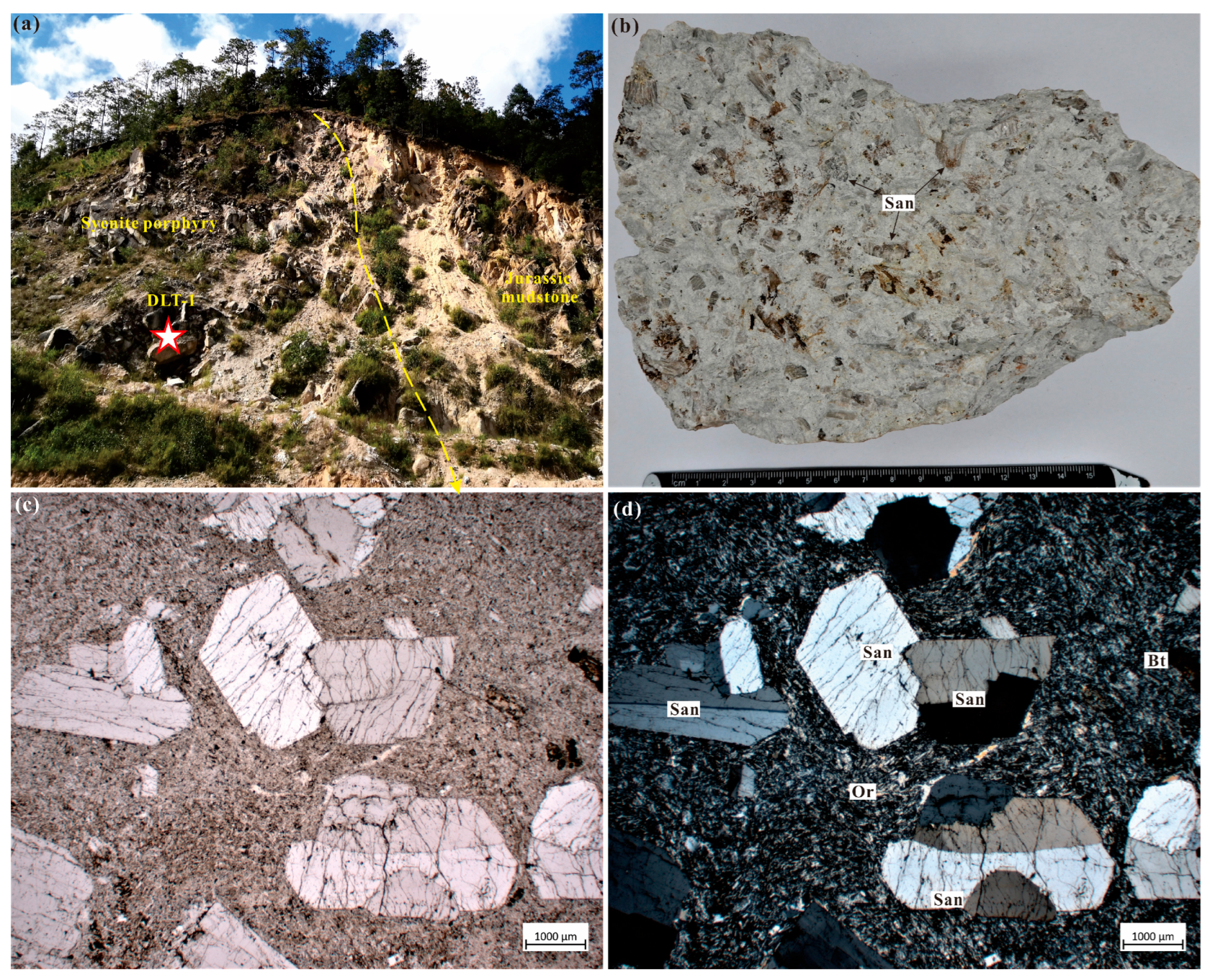
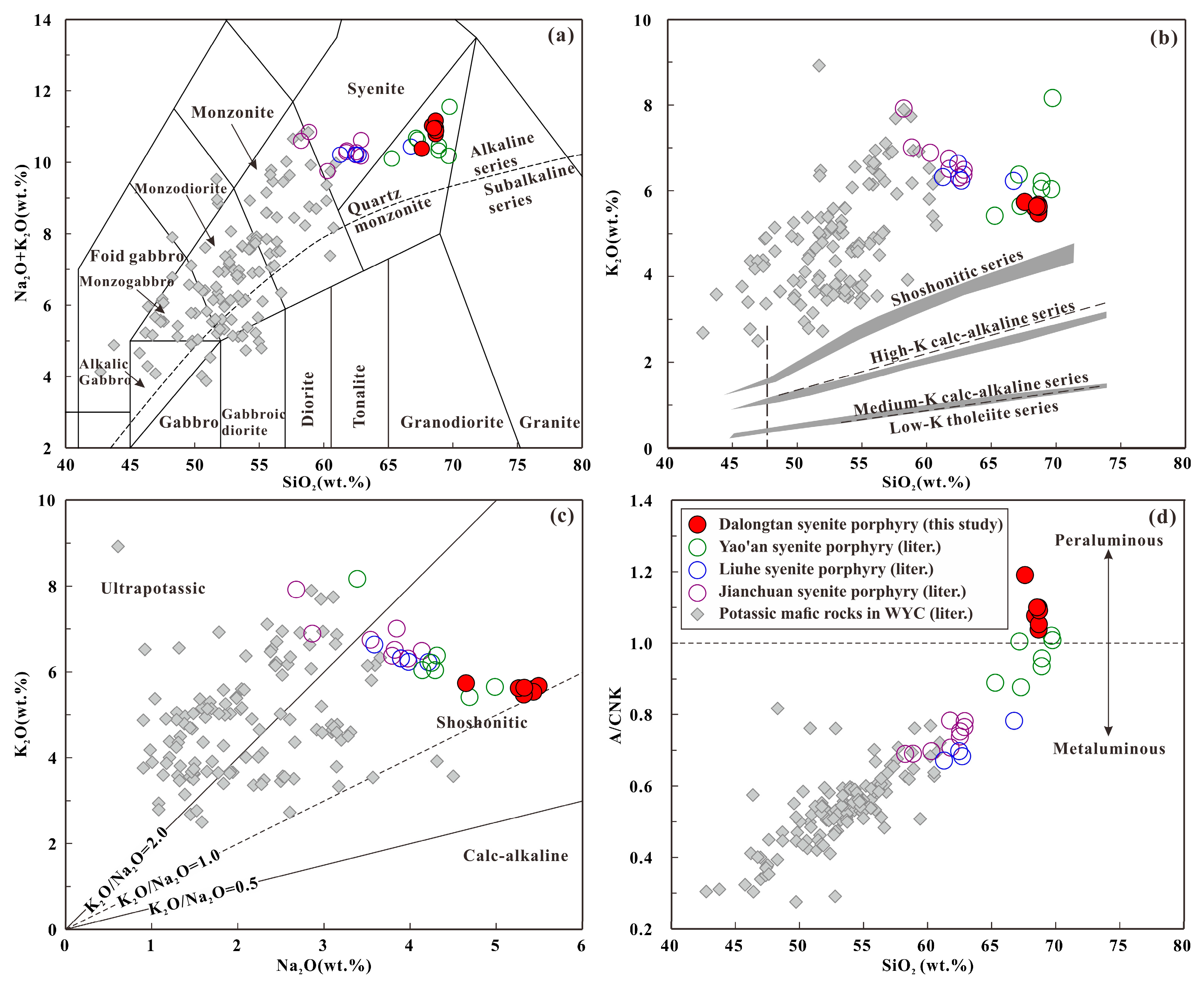

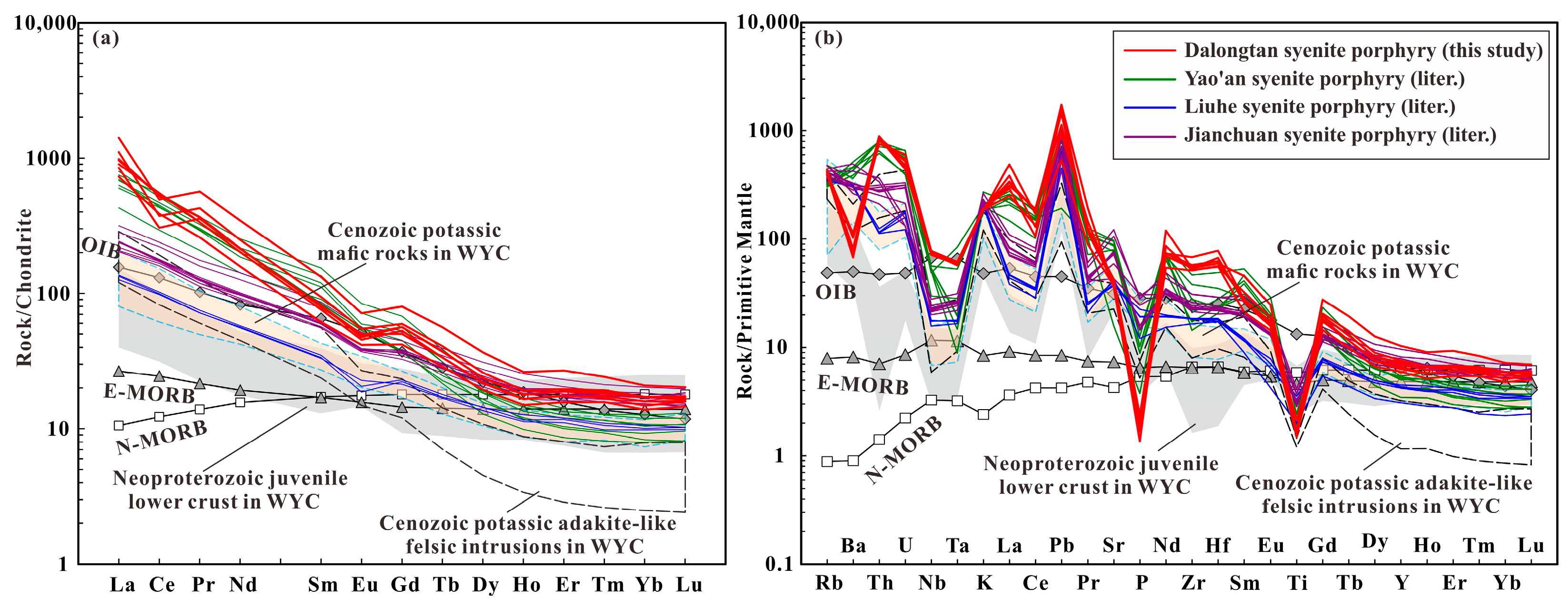
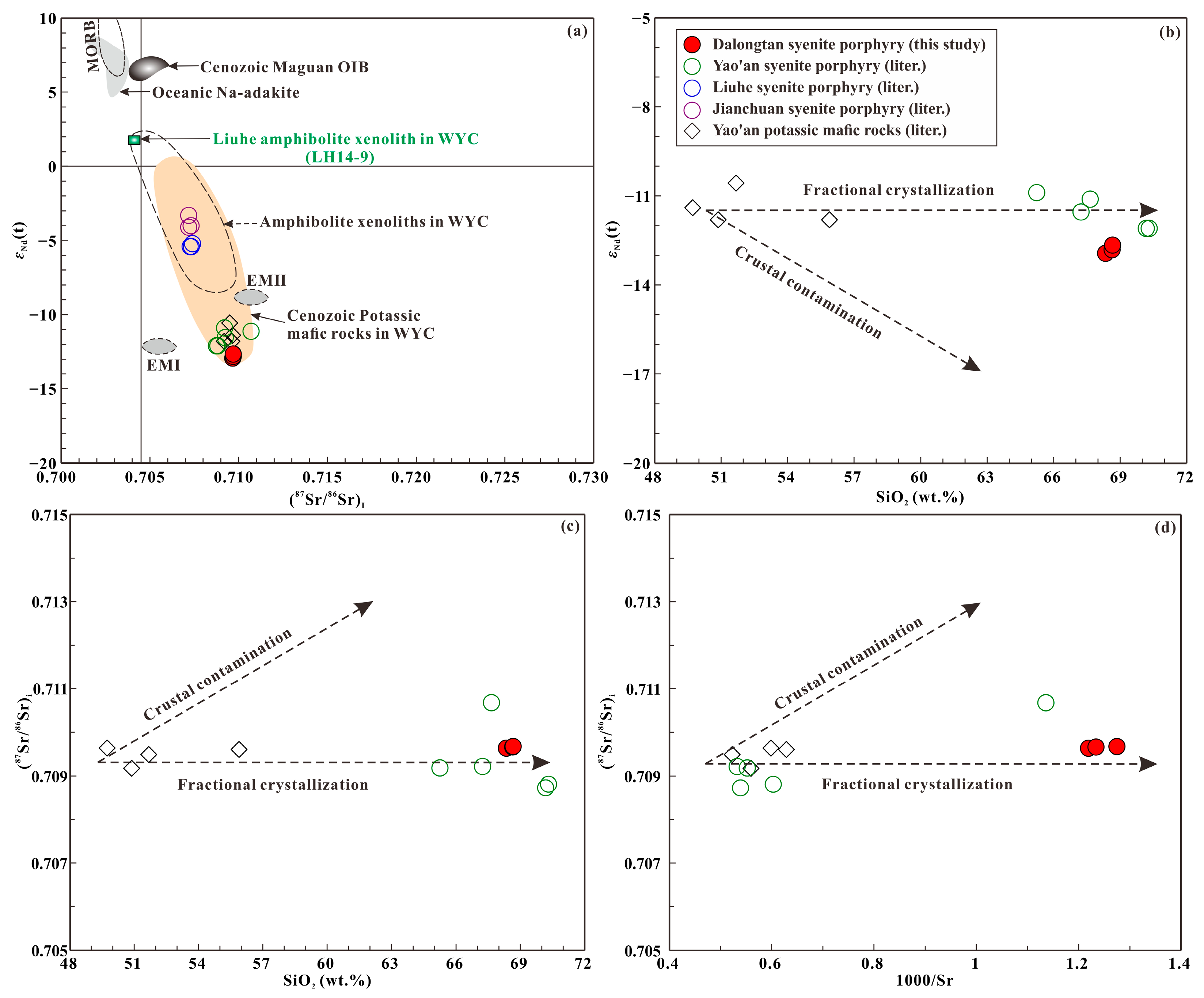
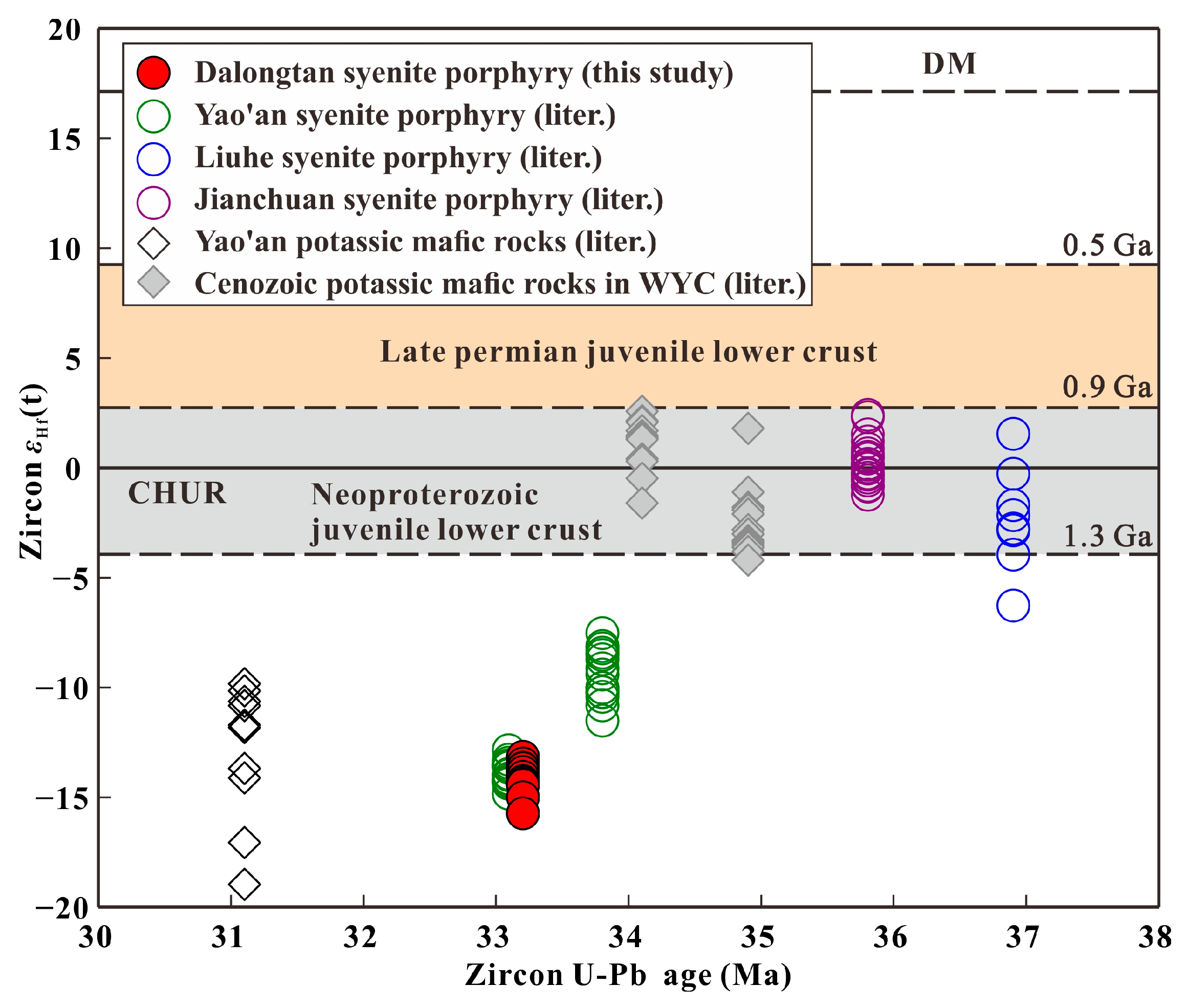
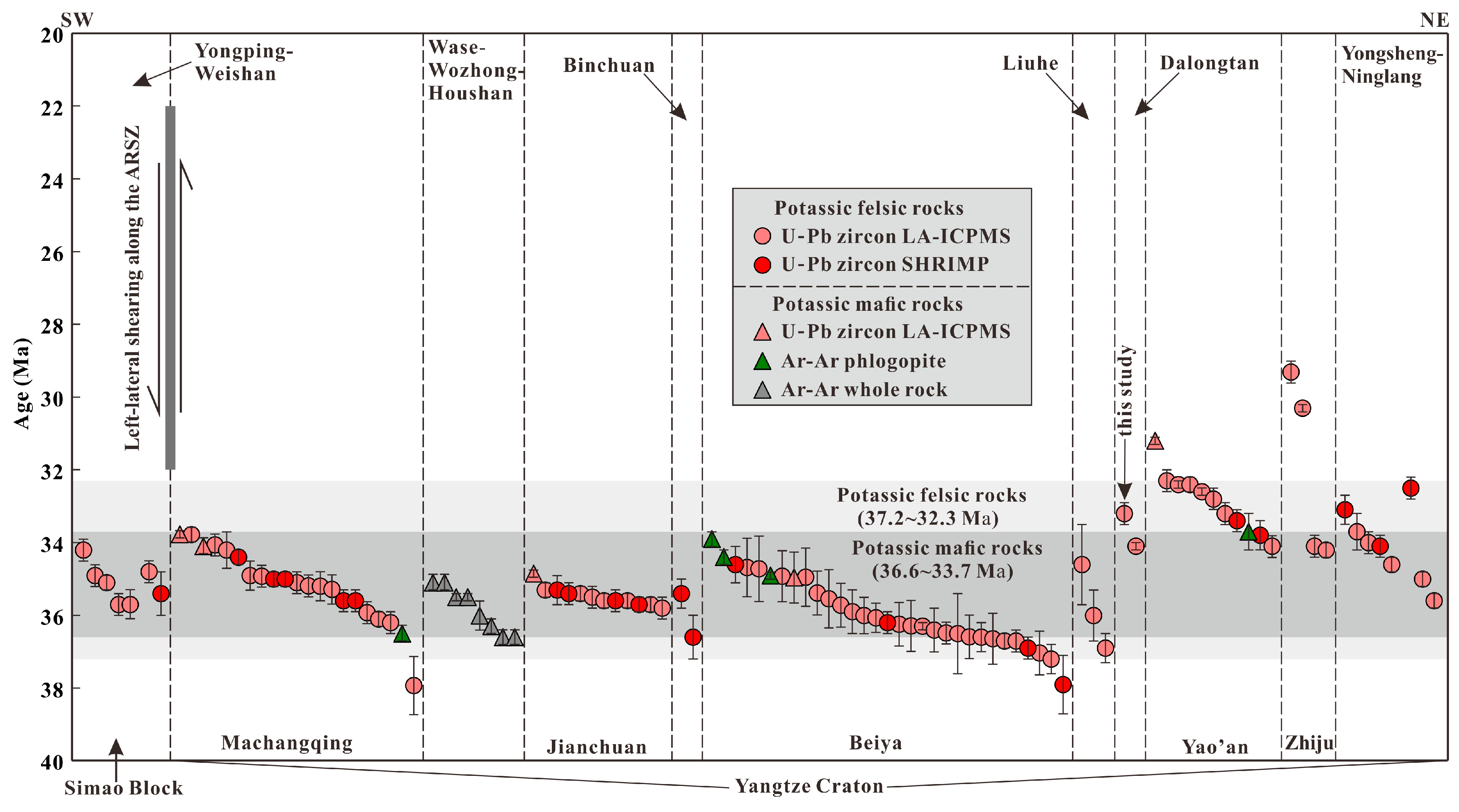

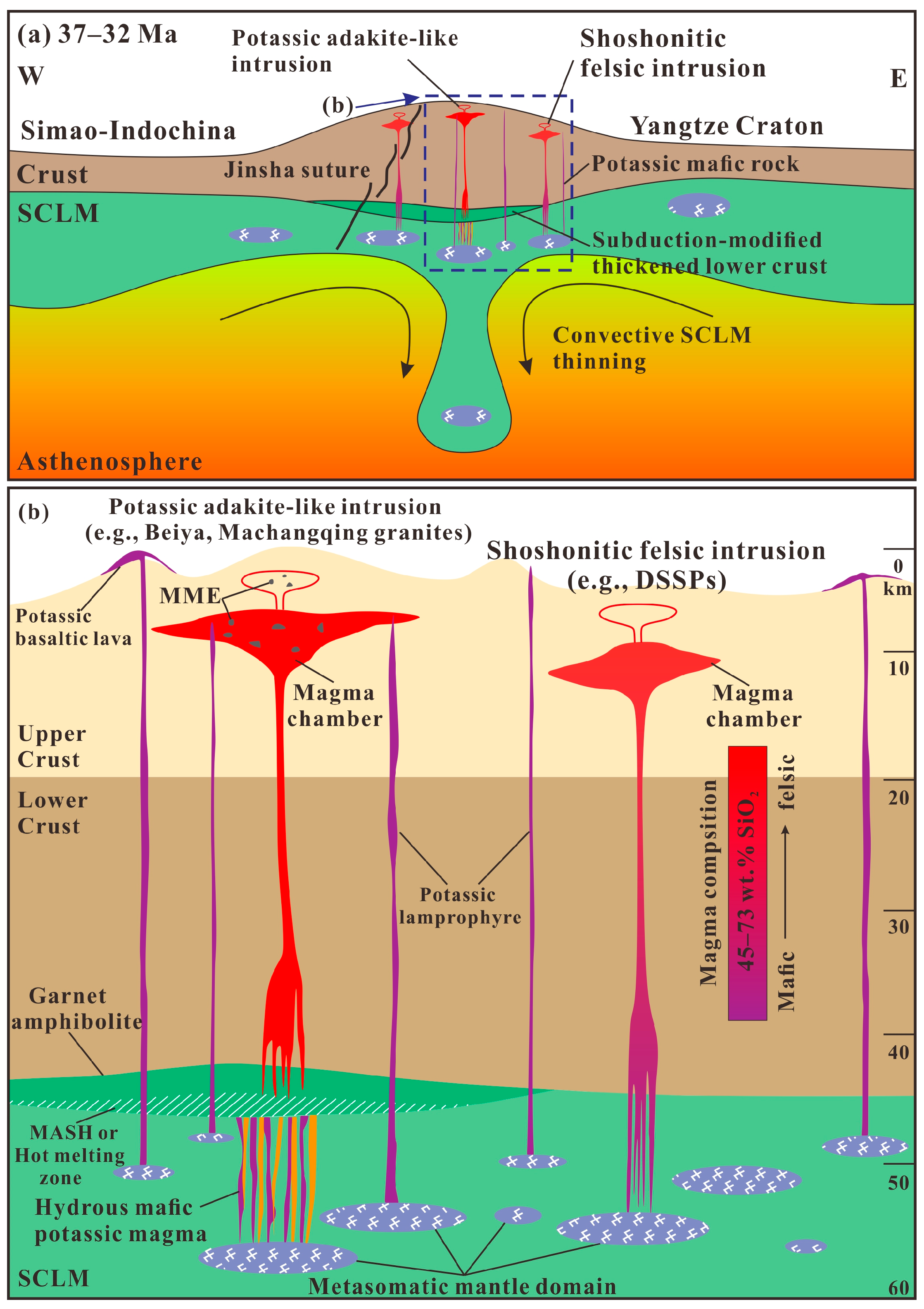
| Spot | 176Yb/177Hf | 176Lu/177Hf | 176Hf/177Hf | 1σ | 176Hf/177Hfi | εHf(0) | εHf(t) | TDM1 (Ma) | TDM2 (Ma) | fLu/Hf |
|---|---|---|---|---|---|---|---|---|---|---|
| DLT-1-02 | 0.023702 | 0.000731 | 0.282372 | 0.000014 | 0.282371 | −14.2 | −13.5 | 1233 | 1965 | −0.98 |
| DLT-1-04 | 0.044646 | 0.001341 | 0.282380 | 0.000014 | 0.282380 | −13.9 | −13.1 | 1241 | 1946 | −0.96 |
| DLT-1-05 | 0.020703 | 0.000605 | 0.282360 | 0.000016 | 0.282360 | −14.6 | −13.8 | 1245 | 1990 | −0.98 |
| DLT-1-06 | 0.047578 | 0.001405 | 0.282367 | 0.000014 | 0.282366 | −14.3 | −13.6 | 1262 | 1976 | −0.96 |
| DLT-1-08 | 0.053278 | 0.001608 | 0.282345 | 0.000013 | 0.282344 | −15.1 | −14.4 | 1300 | 2025 | −0.95 |
| DLT-1-09 | 0.019241 | 0.000581 | 0.282365 | 0.000013 | 0.282365 | −14.4 | −13.7 | 1237 | 1979 | −0.98 |
| DLT-1-12 | 0.021664 | 0.000653 | 0.282347 | 0.000013 | 0.282347 | −15.0 | −14.3 | 1265 | 2020 | −0.98 |
| DLT-1-13 | 0.043184 | 0.001214 | 0.282308 | 0.000019 | 0.282307 | −16.4 | −15.7 | 1339 | 2108 | −0.96 |
| DLT-1-14 | 0.034121 | 0.001028 | 0.282355 | 0.000013 | 0.282354 | −14.8 | −14.1 | 1266 | 2002 | −0.97 |
| DLT-1-18 | 0.035377 | 0.001057 | 0.282346 | 0.000013 | 0.282345 | −15.1 | −14.4 | 1280 | 2023 | −0.97 |
| DLT-1-21 | 0.025693 | 0.000791 | 0.282328 | 0.000015 | 0.282328 | −15.7 | −15.0 | 1296 | 2063 | −0.98 |
| DLT-1-22 | 0.038550 | 0.001174 | 0.282350 | 0.000014 | 0.282349 | −14.9 | −14.2 | 1278 | 2013 | −0.96 |
Disclaimer/Publisher’s Note: The statements, opinions and data contained in all publications are solely those of the individual author(s) and contributor(s) and not of MDPI and/or the editor(s). MDPI and/or the editor(s) disclaim responsibility for any injury to people or property resulting from any ideas, methods, instructions or products referred to in the content. |
© 2024 by the authors. Licensee MDPI, Basel, Switzerland. This article is an open access article distributed under the terms and conditions of the Creative Commons Attribution (CC BY) license (https://creativecommons.org/licenses/by/4.0/).
Share and Cite
Yang, H.; Liu, A.; Wu, P.; Wang, F. Petrogenesis and Tectonic Implications of the Oligocene Dalongtan Shoshonitic Syenite Porphyry in Central Yunnan, Southeastern Tibetan Plateau: Constraints from Geochronology, Geochemistry and Sr-Nd-Hf Isotopes. Minerals 2024, 14, 282. https://doi.org/10.3390/min14030282
Yang H, Liu A, Wu P, Wang F. Petrogenesis and Tectonic Implications of the Oligocene Dalongtan Shoshonitic Syenite Porphyry in Central Yunnan, Southeastern Tibetan Plateau: Constraints from Geochronology, Geochemistry and Sr-Nd-Hf Isotopes. Minerals. 2024; 14(3):282. https://doi.org/10.3390/min14030282
Chicago/Turabian StyleYang, Hang, Anlin Liu, Peng Wu, and Feng Wang. 2024. "Petrogenesis and Tectonic Implications of the Oligocene Dalongtan Shoshonitic Syenite Porphyry in Central Yunnan, Southeastern Tibetan Plateau: Constraints from Geochronology, Geochemistry and Sr-Nd-Hf Isotopes" Minerals 14, no. 3: 282. https://doi.org/10.3390/min14030282
APA StyleYang, H., Liu, A., Wu, P., & Wang, F. (2024). Petrogenesis and Tectonic Implications of the Oligocene Dalongtan Shoshonitic Syenite Porphyry in Central Yunnan, Southeastern Tibetan Plateau: Constraints from Geochronology, Geochemistry and Sr-Nd-Hf Isotopes. Minerals, 14(3), 282. https://doi.org/10.3390/min14030282







